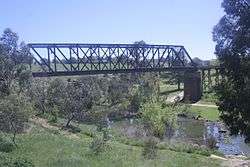Yass River
The Yass River, a perennial river[1] that is part of the Murrumbidgee catchment within the Murray–Darling basin, is located in the Southern Tablelands and South Western Slopes districts of New South Wales, Australia.
| Yass Cohen Creek[1] | |
|---|---|
 A railway bridge over the Yass River. | |
 Location of the Yass River mouth in New South Wales | |
| Etymology |
|
| Location | |
| Country | Australia |
| State | New South Wales |
| Region | South Eastern Highlands (IBRA), Riverina, Southern Tablelands, South Western Slopes |
| LGAs | Queanbeyan–Palerang, Yass Valley |
| City | Yass |
| Physical characteristics | |
| Source | Great Dividing Range |
| • location | near Wamboin |
| • elevation | 758 m (2,487 ft) |
| Mouth | confluence with the Murrumbidgee River |
• location | Lake Burrinjuck |
• coordinates | 34°52′36″S 148°46′55″E |
• elevation | 345 m (1,132 ft) |
| Length | 139 km (86 mi) |
| Basin features | |
| River system | Murrumbidgee catchment, Murray-Darling basin |
| Tributaries | |
| • left | Back Creek (New South Wales), Murrumbateman Creek |
| • right | Cohen Creek, Black Joes Creek, Bungendore Creek, Brooks Creek, Derringullen Creek |
| [1][3] | |
Course and features
The river rises in rugged country south west of Bungendore, near Wamboin and flows generally north north west then south west, joined by seven minor tributaries, towards its confluence with the Murrumbidgee River into the impounded waters of Lake Burrinjuck, west of Yass; dropping 413 metres (1,355 ft) over its 139-kilometre (86 mi) course.[3]
Etymology
A number of competing theories exist as to the origin of the name "Yass". It is believed to be named after an Aborigine commented to explorer, Hamilton Hume, that "Yass boss, plains". An alternative theory is that Yass was named after comments made by Mr Angel, a member of Hume's exploration party, that "Yas, yas, plenty of clear country here". A third theory is that the local Aboriginal Gandangara people used the words Yarrh or Yharr as the name for the river,[2] literally translated to mean "running water".[4]
See also
- List of rivers of Australia
- List of rivers of New South Wales (L-Z)
- Rivers of New South Wales
References
- "Yass River". Geographical Names Register (GNR) of NSW. Geographical Names Board of New South Wales. Retrieved 20 January 2013.

- "Yass". Geographical Names Register (GNR) of NSW. Geographical Names Board of New South Wales. Retrieved 20 January 2013.

- "Map of Yass River". Bonzle Digital Atlas of Australia. Retrieved 20 January 2013.
- "Yass: Brief History". The Southern Tablelands of NSW: Towns & Villages. Retrieved 20 January 2013.
External links
- "Murrumbidgee and Lake George catchments" (map). Office of Environment and Heritage. Government of New South Wales.